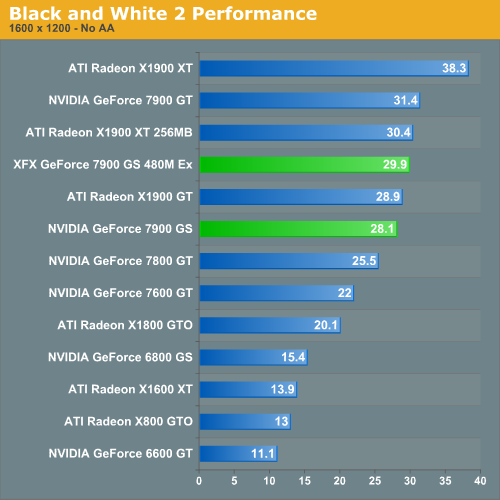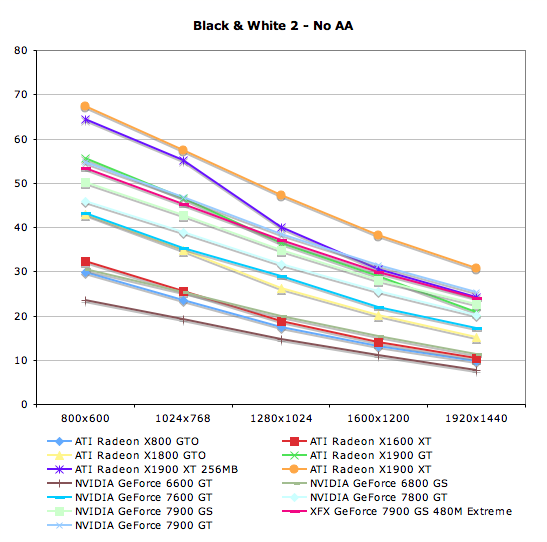Fall '06 NVIDIA GPU Refresh - Part I: GeForce 7900 GS
by Derek Wilson on September 6, 2006 9:00 AM EST- Posted in
- GPUs
Black & White 2 Performance
The AnandTech benchmark for Black & White 2 is a FRAPS benchmark. Between the very first tutorial land and the second land there is a pretty well rounded cut scene rendered in-game. This benchmark is indicative of real world performance in Black & White 2. We are able to see many of the commonly rendered objects in action. The most stressful part of the benchmark is a scene where hundreds of soldiers come running over a hill, which really pounds the geometry capabilities of these cards. At launch, ATI cards were severely out matched when it came to B&W2 performance because of this scene, but two patches applied to the game and quite a few Catalyst revisions later give ATI cards a much needed boost in performance over what we first saw.
A desirable average framerate for Black & White 2 is anything over 20 fps. The game does remain playable down to the 17-19 fps range, but we usually start seeing the occasional annoying hiccup during gameplay here. While this isn't always a problem as far as getting things done and playing the game, any jerkiness in frame rate degrades the overall experience.
We did test with all the options on the highest quality settings under the custom menu. Antialiasing has quite a high performance hit in this game, and is generally not worth it at high resolutions unless the game is running on a super powerhouse of a graphics card. If you're the kind of person who just must have AA enabled, you'll have to settle for a little bit lower resolution than we tend to like on reasonably priced graphics card. Black & White 2 is almost not worth playing at low resolutions without AA, depth of field, or bloom enabled. At that point, we tend to get image quality that resembles the original Black & White. While various people believe that the original was a better game, no one doubts the superiority of B&W2's amazing graphics.

While spending $200 or more will earn you playable performance at up to 1920x1440 without AA under Black & White 2, the X1900 GT does fall a bit short due to its slightly higher price tag and slightly lower performance compared to the overclocked 7900 GS. As with Battlefield 2, the stock and overclocked 7900 GS parts mostly sandwich the performance of the X1900 GT. This is pretty impressive considering there is only about a 6% difference between the stock and XFX cards in the performance of most games.

| Black & White 2 - No AA | |||||
800x600 |
1024x768 |
1280x1024 |
1600x1200 |
1920x1440 |
|
| ATI Radeon X800 GTO | 29.9 |
23.5 |
17.4 |
13 |
9.7 |
| ATI Radeon X1600 XT | 32.3 |
25.5 |
18.7 |
13.9 |
10.3 |
| ATI Radeon X1800 GTO | 43 |
34.7 |
26.3 |
20.1 |
15.2 |
| ATI Radeon X1900 GT | 55.7 |
46.5 |
36.4 |
28.9 |
20.9 |
| ATI Radeon X1900 XT 256MB | 64.5 |
55.2 |
40.1 |
30.4 |
24.1 |
| ATI Radeon X1900 XT | 67.3 |
57.5 |
47.2 |
38.3 |
30.7 |
| NVIDIA GeForce 6600 GT | 23.5 |
19.2 |
14.7 |
11.1 |
7.7 |
| NVIDIA GeForce 6800 GS | 30.5 |
25.4 |
19.8 |
15.4 |
11.2 |
| NVIDIA GeForce 7600 GT | 43.1 |
35.3 |
28.9 |
22 |
17.2 |
| NVIDIA GeForce 7800 GT | 45.8 |
38.8 |
31.6 |
25.5 |
20.2 |
| NVIDIA GeForce 7900 GS | 50.2 |
42.7 |
34.9 |
28.1 |
22.5 |
| XFX GeForce 7900 GS 480M Extreme | 53.3 |
45.3 |
37.1 |
29.9 |
23.9 |
| NVIDIA GeForce 7900 GT | 54.8 |
46.8 |
38.5 |
31.4 |
25.2 |










29 Comments
View All Comments
phusg - Tuesday, September 12, 2006 - link
Hi Derek,I'm a little late to the ball but still
> cheaper price tag
really grates me! I know it's pretty endemic but it's still logically incorrect. A price tag can be lower of higher, but not cheaper, unless it's the price tag being sold. It's the product itself that can be cheaper.
Cheers Derek and don't let me catch you making this one again or there'll be hell to pay ;-)
Pete
imaheadcase - Thursday, September 7, 2006 - link
Could you post a link to the bf2 demo you use, so we can compare are systems video cards to new ones?Stele - Wednesday, September 6, 2006 - link
At first glance, it seems that ATI has markedly improved their OpenGL implementation, at least for the Doom 3 engine:However, after a moment's thought considering the vast difference in performance from before, and also the following qualifiers:
one can't help but wonder - just wonder - if there's anything here that smells like the last quake.exe driver optimisation trick ... which, curiously enough, was also pulled by ATi (iirc it was during the Radeon 8500's time?). I wonder!
Ryan Smith - Wednesday, September 6, 2006 - link
There's no quackery as far as we know of. The problems with City of Heroes is a shader corruption bug, and a bug related to rendering on a secondary buffer, according to Cryptic(the developers of CoH). Whatever ATI did to speed up OpenGL performance here, they apparently didn't take in to account CoH.Stele - Thursday, September 7, 2006 - link
Excellent! Am deciding between the X1900GT and 7900GS (when the latter shows up in the channels), and this improvement would help strengthen the case for the X1900 a bit. :)S3anister - Wednesday, September 6, 2006 - link
found an XFX version on this card on newegg for 189MIR.http://www.newegg.com/Product/Product.asp?Item=N82...">http://www.newegg.com/Product/Product.asp?Item=N82...
emilyek - Wednesday, September 6, 2006 - link
A worthless sku. x1900gt and x1800xt/gto2 are better and almost $50 cheaper.sharkdude - Wednesday, September 6, 2006 - link
The Oblivion percentages are the same in this graph as in the graph on page 4 for all resolutions when in fact only the 800x600 numbers should be the same. On page 5 the numbers should be 4.1%, 10.1%, 6.4%, and 7.3% for 800x600, 1024x768, 1280x1024, and 1600x1200. Note the text below the chart should also change 15% to 10%.DerekWilson - Wednesday, September 6, 2006 - link
corrected -- but your number for 16x12 appears to be wrong as well. :-)Lifted - Wednesday, September 6, 2006 - link
Thanks for including the 6600 and 6800 cards in the benchmarks.